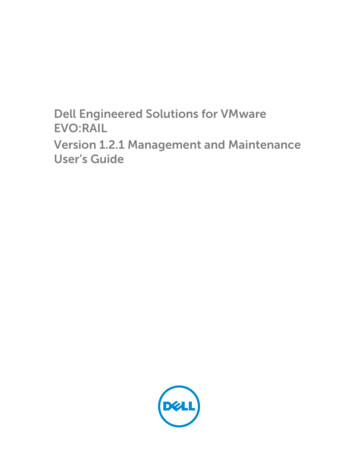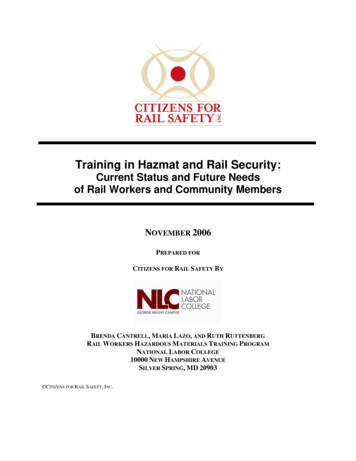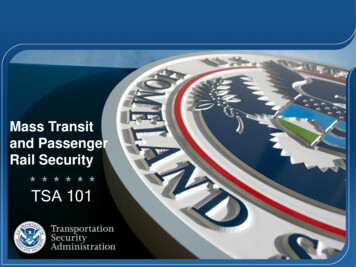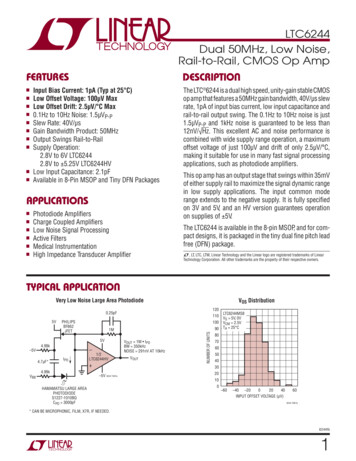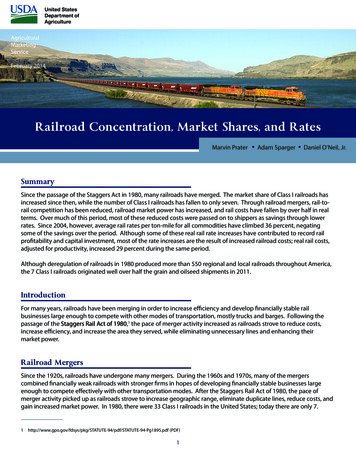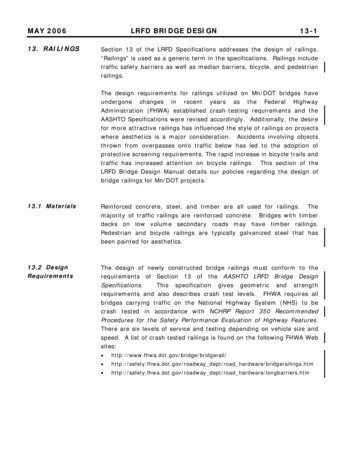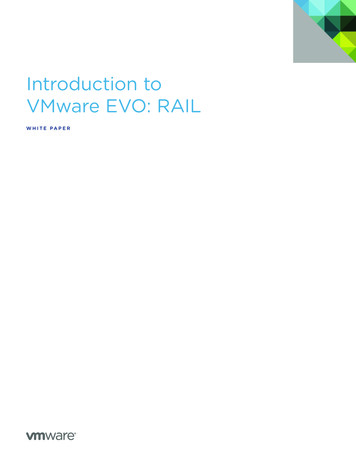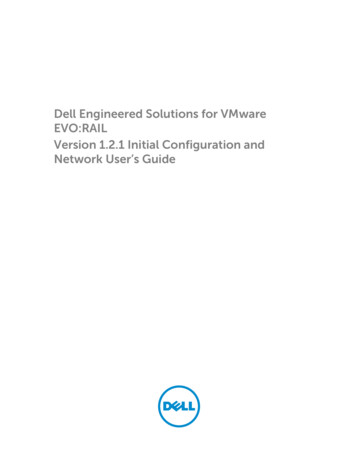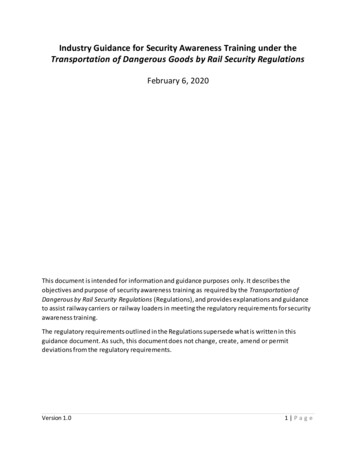
Transcription
Industry Guidance for Security Awareness Training under theTransportation of Dangerous Goods by Rail Security RegulationsFebruary 6, 2020This document is intended for information and guidance purposes only. It describes theobjectives and purpose of security awareness training as required by the Transportation ofDangerous by Rail Security Regulations (Regulations), and provides explanations and guidanceto assist railway carriers or railway loaders in meeting the regulatory requirements for securityawareness training.The regulatory requirements outlined in the Regulations supersede what is written in thisguidance document. As such, this document does not change, create, amend or permitdeviations from the regulatory requirements.Version 1.01 Pa g e
Table of ContentsIntroduction . 3What is Security Awareness? . 3What is Security Awareness Training? . 3What is the Purpose of Security Awareness Training?. 3Overview of the Security Awareness Training Requirement. 4Scope of Application. 4Who does the security awareness training requirement apply to? . 4Who is required to receive security awareness training? . 4Which topics must be included in a security awareness training program? . 5When must security awareness training be provided? . 5What happens if an employee does not have the required training? . 5Security Awareness Training Records. 6What security awareness training records are required? . 6What must the security awareness training records include? . 6How long do records need to be maintained after an employee has left the organization? . 6Program Evaluation . 7Where to find more information . 7Annex A: Planning and Developing a Security Awareness Training Program . 8Phase One – Identifying needs and objectives . 8Phase Two – Designing and developing the training . 9Phase Three – Delivering the training.10Phase Four – Evaluating the training .10Phase Five – Planning and implementing training improvements using the evaluation results .11Security Awareness Training Components .11Version 1.02 Pa g e
IntroductionWhat is Security Awareness?Security awareness means engaging employees, contractors and relevant personnel to makethem aware of their roles and responsibilities in relation to security matters. This includesincreasing their awareness of their surroundings and familiarity with potential security issues,procedures and how they should respond to such situations.What is Security Awareness Training?Security awareness training is a formal process for enhancing employees’ familiarity withsecurity issues and making them more aware of their roles and responsibilities in relation tosecurity matters. A security awareness training program contributes to the development of astrong security culture within a company, whereby relevant employees understand and accepttheir responsibility to contribute to the security of the organization. The goal of this training isto raise awareness to mitigate known risks related to terrorism, unlawful interference, or anypotential threats and other security concerns (e.g. theft, vandalism and unwarrantedsurveillance). In doing so, security becomes a part of a company’s day-to-day activities to helpcontribute to a safe and secure transportation system.What is the Purpose of Security Awareness Training?The purpose of security awareness training is to: Increase an individual’s general understanding of the potential threats to, andvulnerabilities within, the rail transportation network and what actions can be taken tomitigate, control, prepare for, or respond to those threats and vulnerabilities; Prepare them for their responsibilities relative to security; Increase the level of familiarity with general security issues throughout the organization; Develop a strong security culture across all levels of the company; and Introduce the following concepts related to security awareness: prevention, mitigation,response and recovery.Version 1.03 Pa g e
Overview of the Security Awareness Training RequirementRefer to sections 14 and 15 of the Transportation of Dangerous Goods by Rail Security Regulations forthe full text of the Security Awareness Training and Training Records requirements.This provision comes into force for railway carriers on February 6, 2020 and for railway loaders on May 6,2020.Scope of ApplicationWho does the security awareness training requirement apply to?This requirement applies to railway carriers or railway loaders who meet the followingdefinitions included in the Regulations:Railway carrier means a person who has possession of dangerous goods for the purposes oftransportation by railway vehicle on a main railway line, or for the purposes of storing them inthe course of such transportation.Railway loader means(a) any person that operates a handling site, or(b) any manufacturer or producer of dangerous goods that has possession of dangerousgoods at a handling site for the purposes of loading them prior to, or unloading them after,transportation by rail.The term“indirectly” isintended to capturepersons who arenot directemployees of thecompany. This couldinclude third partycontractors whooffers for transport,handles ortransportsdangerous goodsfor the railwaycarrier or railwayloader.Version 1.0Handling site means a facility connected to a railway line where a railwayvehicle is placed for the loading or unloading of dangerous goods.Who is required to receive security awareness training?A person who is employed by or is acting directly or indirectly for arailway carrier or railway loader is required to receive security awarenesstraining if the person: Offers for transport, handles or transports any of the dangerousgoods by railway vehicle, in Canada; or Has duties, in Canada, regarding the security of the transportationof dangerous goods by railway vehicle but does not perform anyof the duties referred to above. (This could include railway police,the rail security coordinator, or security officers occupying aposition in an office environment).4 Pa g e
Which topics must be included in a security awareness trainingprogram?When developing a security awareness training program, a railway carrier or railway loadershould determine the type of training necessary to ensure that the required persons receive theappropriate training to fulfill their security-related responsibilities.While additional topics may be included, the following topics must be included in the trainingprogram: Security risks posed by the dangerous goods that the railway carrier or railway loaderoffers for transport, handles or transports; Measures that are designed to enhance rail security; and Recognition of and response to potential threats and other security concerns.Some examples of the above topics include, but are not limited to: Familiarizing employees with known general security risks identified by the company; Overview of employees’ roles and responsibilities; and How to detect, report and respond to potential security threats, suspicious behaviour oritems, and security incidents.When must security awareness training be provided?Railway carriers or railway loaders must ensure that the security awareness training is provided: Before the person (referred to in paragraph 14(2)(a)) undertakes their security-relatedduties, unless the person has previously received equivalent training; Within six months of this requirement coming into force and before a person withduties referred to in paragraph 14(2)(b) undertakes their security related duties (unlessthe person has previously received equivalent training); and To all required persons, on a recurrent basis at least once every three years includingany equivalent training received before the coming into force of this regulatoryrequirement.Equivalent training may be assessed by Transport Canada on a case-by-case basis to determinewhether the equivalent training meets the regulatory requirement.What happens if an employee does not have the required training?Supervision by a trained employee is required if a person with the duties referred to inparagraph 14(2)(b) has not received security awareness training. Until this person has receivedthe training, they must perform their duties under the supervision of a person who hasundergone that training.Version 1.05 Pa g e
Security Awareness Training RecordsWhat security awareness training records are required?A railway carrier or railway loader must have a training record for each person who hasreceived security awareness training.The format of a company’s security awareness training records and the location of storage is atthe discretion of the company. Records may be kept electronically, in paper format or through acombination of these means.What must the security awareness training records include?Security awareness training records must include: The person’s name and details of their most recent training session, as well as thefollowing information:o Date of the training;o Duration of the training;o Title of course;o Delivery method; ando Name of the training provider, if applicable. The name of the training provider refers to the individual or company thatprovided the training. For example this could be an employee of the railwaycarrier or railway loader whose responsibility it is to provide training or acontracted entity or third party training provider. The training record must also include the title and date of each training session that theperson has received.How long do records need to be maintained after an employee has leftthe organization?Records must be retained for at least two years after the day on which the employee is nolonger employed by or acting directly or indirectly for the railway carrier or railway loader.Version 1.06 Pa g e
Program EvaluationA company’s security awareness training program should be reviewed and evaluated regularlyto confirm its effectiveness.Examples of baseline measures that may assist in measuring the effectiveness and relevance ofthe security awareness training provided to employees, could include, for example: Employees can define suspicious behaviour and know what to do when suspiciousbehavior is identified; Employees can define suspicious objects and know what to do when suspicious objectsare identified; and Employees know how to report an incident, suspicious behaviour or objects.Where to find more informationFor general information regarding Transport Canada’s rail security program tm.For general inquiries to headquarters email: ion 1.07 Pa g e
Annex A: Planning and Developing a Security Awareness TrainingProgramFor additional information, please refer to the Code of Practice on Employee Training andAwareness for Rail and Urban Transit Security. A copy of the Code of Practice is available uponrequest at TC.Railsecurity-sureteferroviaire.TC@tc.gc.ca.The information below is optional guidance on developing a security awareness trainingprogram that may be of value to some railway carriers and railway loaders.A security awareness training program will vary based on the size and complexity of thecompany and its operations.A security awareness training program may be stand-alone or integrated into a company’sother training and awareness programs. Security awareness training programs should beupdated periodically to ensure they remain current and effective. Such programs should alsoinclude a regular evaluation of their successes, ongoing effectiveness and relevance. Inaddition, training and awareness programs should reflect operational needs, the company’ssecurity context and the measures contained in its security plan, if applicable.The following information stems from Transport Canada’s Codes of Practice that w eredeveloped in conjunction with rail and transit industry leaders under the voluntaryMemorandum of Understanding on Railway Security between Transport Canada and theRailway Association of Canada. The material below is intended to provide railway carrie rs andrailway loaders with information that may assist them in developing a security awarenesstraining program. Companies may adopt aspects of this information in whole or in part, thatbest suits their particular security and operational needs.Security awareness training programs can be developed and conducted using a five -phasecycle:1. Identifying needs and objectives;2. Designing and developing the program;3. Delivering the program;4. Evaluating the program; and5. Planning and implementing program improvements using the evaluation results.Phase One – Identifying needs and objectivesTo determine what training is required to ensure that employees are able to fulfill theirsecurity-related responsibilities, a railway carrier or railway loader should conduct a needsassessment, for example: The railway carrier or railway loader should assess and know the security risks andvulnerabilities facing its operations;Version 1.08 Pa g e
Review its security plan (if applicable), policies and procedures to identify the securityrelated roles, responsibilities and tasks employees, contractors and other requiredpersons are expected to fulfill to mitigate the vulnerabilities and impacts to theiroperations; andReview its existing security awareness training (if any) to identify any gaps betw een thetraining and awareness the required persons currently receive and the security-relatedtasks and responsibilities they are expected to fulfill.For railway carriers and railway loaders with an existing security awareness training program, aperformance review may be conducted to identify potential training or awarenessshortcomings, for example: Review reports on security exercises (if applicable) or incidents to identify anyshortcomings in employees’, contractors’ or other required persons performance duringthose accidents or incidents (e.g. did they fulfill their security-related roles andresponsibilities); and Review security-related training records of the employees, contractors or other requiredpersons involved in those exercises or incidents to determine if there is a link betweenany identified performance shortcomings and the security-related training they hadreceived.The results of the needs assessment can be used to establish the objectives of the securityawareness training, which provide a framework for developing the training and serve as thebasis for the evaluation criteria used to assess the training.Phase Two – Designing and developing the trainingThe design of a security awareness training program should reflect the needs and objectivesidentified in Phase one. Below are examples of tasks the training could include: Assembling a planning team; Developing training material and documentation; Identifying employees needing training and the relevant training to be provided; Determining what training information contractors, visitors and other persons (whohave access to the property of railway carriers/railway loaders) need; Scheduling training sessions; Budgeting for training sessions; Developing assessment criteria and a method to confirm the effectiveness of thetraining received; Developing a method to track courses offered, participant attendance, frequency ofrefresher training courses, etc.; Determining who or which department is responsible for the training and how it will bedocumented/tracked; Identifying the training delivery methods; Identifying service providers if training is outsourced; and Identifying an evaluation criteria and methodology for the security awareness training.Version 1.09 Pa g e
When selecting a delivery method for the security awareness training, consideration should begiven to factors, such as the availability of internal resources, objectives, costs, participants,frequency, geography and the nature of messages (e.g. detailed procedures vs. basicinformation).Phase Three – Delivering the trainingOnce security awareness training has been developed, delivery may take place using a varietyof formats.Delivery methods of a security awareness training programSecurity awareness training may be delivered in the following formats to introduce the requiredpersons to their working environment and outline their responsibilities: Orientation sessions; Presentations or videos; In-class instructions; Workshops; On-the-job training; and/or Computer-based training.For structured on-the-job training, it should be noted that this requires more thought andpreparation and it is important to have a system in place to determine whether trainees havegained the knowledge and skills required to do the job.Additional tools for the training could include printed material (e.g. posters, flyers, newsletters,or bulletins) or videos that may serve as a primary awareness raising technique. All of the toolsused in the training material should have clear and well-communicated messaging written inplain language.Phase Four – Evaluating the trainingSecurity awareness training should include an application component (e.g. via an exercise ortest) to provide relevant employees the opportunity to “learn by doing”. This will helpemployees understand their security responsibilities more thoroughly and help railway carriersor railway loaders verify employees’ familiarity with the content of the security awarenesstraining received.Using the assessment criteria created in Phase Two, railway carriers or railway loaders shouldperiodically evaluate the results of their security awareness training to see if objectives weremet. Lessons learned while evaluating the training should be developed to improve trainingeffectiveness and inform the next iteration of the training planning phase.Version 1.010 P a g e
Phase Five – Planning and implementing training improvements usingthe evaluation resultsAfter evaluating the results of the security awareness training, railway carriers or railwayloaders should determine how they will address shortcomings and build on successes. Railwaycarriers or railway loaders should use the evaluation criteria to determine which trainingcompetencies require improvement. It is encouraged to continuously strive to improve andupdate the company’s security awareness training program.Security Awareness Training ComponentsA security awareness training program may include, but it is not limited to, information ondetecting, reporting and responding to potential security threats, suspicious behavior orobjects, security incidents and other security concerns. How to detect and identify:o Potential security threats (e.g. unauthorized persons in restricted areas orevidence of);o Suspicious behaviour (e.g. surveillance, photographs etc.);o Suspicious objects (e.g. using the HOT principle – Hidden, Obviously suspicious,not Typical); ando Security incidents. How to report on security threats, suspicious behaviour or objects and security incidentsand concerns including:o Who to contact and how to contact them (e.g. using emergency hotlines); ando What key information should be reported (e.g. the Who, What, Where, When,Why, and How and the details of persons, objects or vehicles involved). How to respond to potential security threats, suspicious behaviour or objects andsecurity incidents, for example:o Following emergency response procedures with respect to evacuating and exitpoints, using emergency equipment, isolating dangerous areas and seekingassistance.Version 1.011 P a g e
Transportation of Dangerous Goods by Rail Security Regulations February 6, 2020 This document is intended for information and guidance purposes only. It describes the objectives and purpose of security awareness training as required by the Transportation of Dangerous by Rail Security Regulations (Regulations), and provides explanations and guidance
